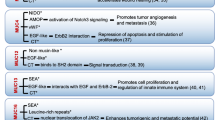Abstract
Purpose
The identification of novel cell lines which combine the most important properties of mucosal membranes in terms of drug absorption, transmembrane transport and mucus secretion can help to establish improved and meaningful test systems for pharmacological and infectiological studies.
Methods
We have established a novel mucus secreting tumor cell line (Cx-03) derived from a female patient who underwent radical hysterectomy after diagnosis of a large malignant carcino sarcoma (Muellerian mixed tumor). Via xenotransplantation in SCID beige mice, recultivation and subcloning a stable cell line was established from primary tumor cells.
Results
Human origin and novelty of the cell line was determined by karyotype analysis and STR fingerprint. During growth cells produce considerable amounts of a PAS positive viscoelastic mucus. Immunostaining revealed expression of mucins and the mucin modifier CLCA1. We demonstrate in initial electrophysiological experiments that confluent, polarized monolayers of Cx-03 are formed (on PCF-filter supports) that exhibit stable electrical resistance (> 600 Ω cm2). Confluent Cx-03 monolayers express barrier-forming tight junction proteins claudin-1 and -4 which co-localize with zonula occludens protein-1 (ZO-1) at cell-cell contacts.
Conclusions
Mucus secretion is a rare property among mammalian cell lines. In combination with its ability to form polarized monolayers Cx-03 might contribute as a novel cell based model for drug absorption, transport and barrier studies.








Similar content being viewed by others
References
Johansson ME, Hansson GC. Immunological aspects of intestinal mucus and mucins. Nat Rev Immunol. 2016;16(10):639–49.
Lechanteur A, das Neves J, Sarmento B. The role of mucus in cell-based models used to screen mucosal drug delivery. Adv Drug Deliv Rev. 2018;124:50–63.
Fogh J. Human tumor cells in vitro. New York: Plenum Press; 1975. p. 115–41.
Pinto M, Appay MD, Simon-Assan P, Chevalier G, Dracopoli N, Fogh J, et al. Enterocytic differentiation of cultured human colon cancer cells by replacement of glucose by galactose in the medium. Biol Cell. 1982;47:193–6.
Walter E, Janich S, Roessler BJ, Hilfinger JM, Amidon GL. HT29-MTX/Caco-2 cocultures as an in vitro model for the intestinal epithelium: in vitro-in vivo correlation with permeability data from rats and humans. J Pharm Sci. 1996;85(10):1070–6.
Kernéis S, Bogdanova A, Kraehenbuhl JP, Pringault E. Conversion by Peyer's patch lymphocytes of human enterocytes into M cells that transport bacteria. Science. 1997;277(5328):949–52.
Gullberg E, Leonard M, Karlsson J, Hopkins AM, Brayden D, Baird AW, et al. Expression of specific markers and particle transport in a new human intestinal M-cell model. Biochem Biophys Res Commun. 2000;279(3):808–13.
des Rieux A, Fievez V, Théate I, Mast J, Préat V, Schneider YJ. An improved in vitro model of human intestinal follicle-associated epithelium to study nanoparticle transport by M cells. Eur J Pharm Sci. 2007;30(5):380–91.
Owen DH, Katz DF. A vaginal fluid simulant. Contraception. 1999;59:91–5.
das Neves J, Rocha CM, Goncalves MP, Carrier RL, Amiji M, Bahia MF, et al. Interactions of microbicide nanoparticles with a simulated vaginal fluid. Mol Pharm. 2012;9:3347–56.
Burruano BT, Schnaare RL, Malamud D. Synthetic cervical mucus formulation. Contraception. 2002;66:137–40.
Konat G, Gantt G, Laszkiewicz I, Hogan EL. Rapid isolation of genomic DNA from animal tissues. Exp Cell Res. 1990;190(2):294–6.
Dirks WG, MacLeod RA, Nakamura Y, Kohara A, Reid Y, Milch H, Drexler HG, Mizusawa H. Cell line cross contamination initiative: an interactive reference database of STR profiloes coveringg common cancer cell lines. Int J Cancer. 2010;126(1):303–4
Kottler MJ. From 48 to 46: Cytological technique, preconception, and the counting of human chromosomes. Bull Hist Med. 1974;48(4):465–502
Bücker R, Troeger H, Kleer J, Fromm M, Schulzke JD. Arcobacter butzleri induces barrier dysfunction in intestinal HT-29/B6 cells. J Infect Dis. 2009;200(5):756–64.
Leverkoehne I, Gruber AD. The murine mCLCA3 (alias gob-5) protein is located in the mucin granule membranes of intestinal, respiratory, and uterine goblet cells. J Histochem Cytochem. 2002;50(6):829–38.
Nyström EL, Birchenough GMH, van der Post S, Arike L, Gruber AD, Hansson GC, et al. Calcium-activated chloride channel regulator 1 (CLCA1) controls mucus expansion in colon by proteolytic activity. EBioMedicine. 2018;33:134–43.
Baker VL. Obstet Gynecol Clin N Am. 1994;21(2):271–97.
Lai SK, Wang YY, Hanes J. Mucus-penetrating nanoparticles for drug and gene delivery to mucosal tissues. Adv Drug Deliv Rev. 2009;61:158–71.
Hanes J, Demeester J. Drug and gene delivery to mucosal tissues: the mucus barrier. Adv Drug Deliv Rev. 2009;61:73–4.
Steinbach JM. Protein and oligonucleotide delivery systems for vaginal microbicides against viral STIs. Cell Mol Life Sci. 2015;72:469–503.
das Neves J. Vaginal delivery of biopharmaceuticals. In: das Neves J, Sarmento B, editors. Mucosal delivery of biopharmaceuticals: biology, challenges and strategies. New York: Springer; 2014. p. 261–80.
das Neves J, Araujo F, Andrade F, Michiels J, Arien KK, Vanham G, et al. In vitro and ex vivo evaluation of polymeric nanoparticles for vaginal and rectal delivery of the anti-HIV drug dapivirine. Mol Pharm. 2013;10:2793–807.
Gali Y, Arien KK, Praet M, Van den Bergh R, Temmerman M, Delezay O, et al. Development of an in vitro dual-chamber model of the female genital tract as a screening tool for epithelial toxicity. J Virol Methods. 2010;165:186–97.
Grammen C, Augustijns P, Brouwers J. In vitro profiling of the vaginal permeation potential of anti-HIV microbicides and the influence of formulation excipients. Antivir Res. 2012;96:226–33.
Lechanteur A, Furst T, Delvenne P, Evrard B, Piel G, Hubert P. Promoting vaginal distribution of E7 and MCL-1 siRNA-silencing nanoparticles for cervical cancer treatment. Mol Pharm. 2017;14:1706–17.
ACKNOWLEDGMENTS AND DISCLOSURES
The study was supported by the Berliner Krebsgesellschaft and the Wilhelm-Sander-Stiftung. The authors would like to thank Prof. Heidemarie Neitzel and Prof. Martin Digweed from the Institute of Genetics (Charité University Medicine Berlin, Germany) for their excellent support. The technical assistance of In-Fah Maria Lee is gratefully acknowledged.
Author information
Authors and Affiliations
Corresponding author
Rights and permissions
About this article
Cite this article
Bücker, R., Schaefer, C., Gruber, A.D. et al. Establishment of a Mucin Secreting Cell Line Cx-03 from an Uterine Carcino Sarcoma. Pharm Res 36, 7 (2019). https://doi.org/10.1007/s11095-018-2533-z
Received:
Accepted:
Published:
DOI: https://doi.org/10.1007/s11095-018-2533-z




